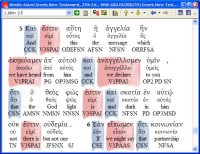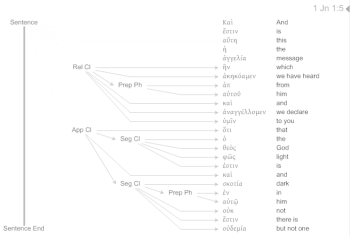When approaching a text, one of the initial steps of exegesis is to do some general background study, thus becoming familiar with the larger context of a passage. If I’m looking at a passage in First John, I should have a decent idea of the author, recipient and setting of the letter. Logos has several resources (commentaries, handbooks, dictionaries, encyclopedias, etc.) that should provide assistance with this general process.
After this initial step, according to many guides to NT exegesis (e.g. Fee’s NT Exegesis) the next step is to work through the the grammar and syntax of the passage. Some guides mention that one should read (and re-read, and re-read) the passage. One must be familiar with the current context and the larger context for exegesis to be effective.
When you’re familiar with the text through the reading (and re-reading) of it, you’ve arrived at the point where detailed picking apart of the text is required. This is the point where one really begins to consider issues of grammar and syntax of the original language.
There are existing resources to consult to learn these things; some are even available in Logos Bible Software. These should be consulted and applied. But detailed reading of a book that provides hints, clues and process for exegesis does not magically transform the reader into a competent and confident exegete of Scripture. This only happens through practice and repetition.
And this is why morphologically and syntactically annotated editions of the primary texts of the Hebrew Bible and the Greek New Testament are necessary. They provide an example for you to check your work against, to use in the sharpening of your own skills. This is very helpful when you don’t have a hard-grading seminary prof check your work for accuracy.
This article walks through some ways to think about clause boundaries using Logos Bible Software; comparing these to the information provided by the Lexham Syntactic Greek New Testament.
Let’s use 1Jn 1.5 as an example. Below is the text from the ESV; though for the balance of this article we’ll work with the text from the NA27 Greek New Testament.
This is the message we have heard from him and proclaim to you, that God is light, and in him is no darkness at all. (1Jn 1.5, ESV)
I’ll assume that the general background work of becoming familiar with the letter has been done. In all likelihood, we’d be looking at the larger context (1Jn 1.5-10) but we’ll keep it to just this one verse for this post.
In Greek, when thinking about clause boundaries, one typically looks for finite verbs. A finite verb is a verb that is not a participle or an infinitive. For the Greek, this means that one wants to know about verbs in the indicative, subjunctive, imperative and perhaps even the optative moods. Normally each clause (the basic unit we want to identify) has one finite verb.
Thus, by identifying the finite verb and the material that goes with it, we can identify the clause.
This is just the sort of thing that Morphological Visual Filters are designed to help with. If we can make the finite verbs visually distinct in the running text of the NA27, then we’ve gone a long way toward identifying the basic clauses. Another little trick is to make conjunctions visually distinct as well since many times they are clues to the start or end of a clause. In linked screen capture (click on thumbnail to right), I’ve specified blue highlighting for conjunctions and red highlighting for finite verbs.
This allows for one to do some basic clause-breaking, as below (verbs in bold, conjunctions in italic):
??? ????? ???? ? ???????
?? ????????? ??? ?????
??? ???????????? ????,
??? ? ???? ??? ?????
??? ?????? ?? ???? ??? ????? ???????.
This is a starting point, however; it is not the end of the process. Next one has to think about how these clauses relate to each other. Which clauses are dependent? Are these boundaries even proper? To help determine this, we can cheat (just a little) and consider the punctuation of the NA27. The comma is helpful; it shows where the editors see a minor break in the sentence. So maybe the following would be better:
??? ????? ???? ? ???????
?? ????????? ??? ????? ??? ???????????? ????,
??? ? ???? ??? ????? ??? ?????? ?? ???? ??? ????? ???????.
It seems, according to the punctuation in the NA27, that the sentence has two dependent clauses; one relative clause and one starting with ???. These dependent clauses likely have multiple parts, though determining the exact function of the conjunctions will take a little more thought.
Going any further, at least for me, is confusing. How do I know what anything does when I don’t have a whole lot of experience making these decisions?
This is where consulting the Lexham Syntactic Greek New Testament is helpful. I’ve stopped and thought about the sentence in question; now I need to consult someone else’s opinion to help me while I work through the finer syntactic details of the text. Here’s 1Jn 1.5 in from the Lexham Syntactic Greek New Testament Sentence Analysis:
Looking at the graph analysis, the Lexham SGNT Sentence Analysis breaks it out something like this:
??? ????? ???? ? ???????
?? ????????? ??? ????? ??? ???????????? ????,
???
? ???? ??? ?????
???
?????? ?? ???? ??? ????? ???????.
So, according to the Lexham SGNT, the relative clause ?? ????????? ??? ????? ??? ???????????? ???? describes the message. The message is further described by a series of two finite clauses subordinated by ??? and joined by ???. These are ? ???? ??? ????? (“God is light”) and ?????? ?? ???? ??? ????? ??????? (“darkness is not in him at all”). That structure, consisting of the two clauses, is appositional. Each embedded clause serves to clarify the other. Some might use the term “epexegetical” or “explanatory” instead of appositional.
The Lexham SGNT provides breaks and labels the reason for the break. Since we thought on our own about the breaks initially, we can compare what the Lexham SGNT has done and think about why these breaks were made and labels applied. In understanding the reasons for these breaks, we can agree or disagree with the analysis; either way it helps inform us the next time clause breaks are analyzed. We’re interacting with the syntax instead of just looking at a picture and then wondering what it means.
This is one reason why the OpenText.org Syntactically Analyzed Greek New Testament will also be available for another opinion. Clause analysis can be compared between the two databases (much like one would compare commentary) so that your own reading of the text can be informed and grounded.
Hopefully this helps in understanding why thinking through clause boundaries is important, and how the new syntax databases help in working through establishing the boundaries.






